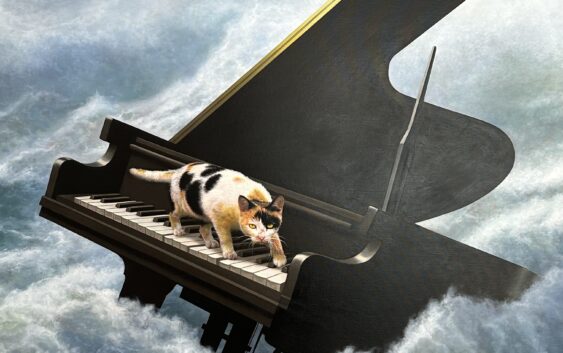Scott Siedman Makes Waves with his “Ocean Views” Art Exhibit at the Kantor Gallery

Scott Siedman Painter Extraordinaire
Scott Siedman’s thought-provoking art exhibit, “Ocean Views,” a powerful response to the climate crisis, is currently on display at the Kantor Gallery in Beverly Hills. The exhibit runs from June 28 to August 1, 2024.
“Ocean Views” masterfully blends realism and abstraction, infusing climate change themes with hope and beauty. The exhibit challenges viewers to consider their role in addressing the urgent environmental crisis, which served as a catalyst for this series of paintings.
Scott Siedman, born in East Los Angeles in 1948, has drawn inspiration from such diverse sources as the artworks of Rembrandt and Magritte, and the film “Wild Strawberries” by Bergman. After working as an illustrator and set designer early on in his career, this multi-talented artist decided to devote himself to painting. In the course of his long and variegated artistic journey, he has continued to explore in his works the mysterious in all its forms while grappling with the fears of every era he has encountered from the 1950’s atomic bomb scares to today’s climate-change anxieties.
In 2000, Siedman became concerned about the effects of climate change and this served as the catalyst for the development of the series “Ocean Views,” his artistic response to the warnings of impending climate catastrophe. Satirical and surreal, serious and sunny, this emerging stream of paintings is stylistically diverse: dramatic lighting effects and bright and cheerful colors are rife amidst depictions of a coming climatological apocalypse, with the result being a concatenation which has been termed “Disney Doomsday,” given its manner of presentation and subject matter.
Works of surrealism are known to feature elements of surprise, unexpected contiguities, and non sequiturs, and Siedman’s “Ocean Views” certainly meets all those criteria. As the artist says, “The art I make is infused with contradiction, ambiguity, and odd juxtapositions. These elements are there because of my natural inclination to doubt the ‘truths’ of my cultural inheritance and my innate contrariness.”
Not one to succumb to despair, Siedman has infused his works with sanguininity by ingeniously inserting abstract art by Brancusi, Giacometti, and David Smith into his apocalyptic settings. These profoundly beautiful works by the above mentioned masters serve as a counterpoint to the surrealistic doom pictured, offering a glimmer of hope. “If humanity could create such art, perhaps we could also invent solutions to our global challenges,” says Siedman.
Three of our favorite pieces from the show:
“In Concert,” the striking image of a cat traversing the keys of a piano floating in an angry sea, the cat seemingly oblivious (or maybe not!) to the pending peril. Here we have humor in the face of horror in an unusual scenario evoking both vulnerability and resilience. This painting is an excellent example of one of the imaginative configurations of Siedman which populate this series.
“Reception,” an intriguing depiction of an interior space which blends modern design and surreal elements. This painting seems to play with perspective, juxtaposing indoor comfort with the vastness of the ominous sky. It evokes thoughts about confinement versus openness as well as human-made catastrophe. Here we see interplay between nature and human-made structures. Creature comforts, bright happy pink colors, and a Giacometti sculpture, so staid and delicate and peaceful, are depicted midst the backdrop of impending doom.
“Cold Comfort,” a thought-provoking and captivating exploration masterfully weaving together vulnerability, strength, sensuality, and danger. In its visual composition, the canvas portrays a striking scene: a naked woman reclining on a bed of ice, her skin pale against the frigid backdrop. Her body curves gracefully, evoking both intimacy and isolation. The central focus, however, lies between her legs—a white polar bear, its fur pristine and powerful. The bear’s gaze pierces through the icy atmosphere, hinting at primal instincts and untamed desires. This scene is perhaps a remembrance of the allegory of Leda and the Swan, in which Zeus, having assumed the form of a swan, seduces the Spartan queen Leda. Siedman’s enigmatic piece invites viewers to contemplate the delicate balance between human fragility and the wild forces of nature. We find ourselves caught between warmth and frost, desire and caution. The canvas whispers secrets, inviting us to ponder our place in the delicate dance of existence. Here, longing and danger coexist, as part of our foray into forbidden territories.
Remember, art transcends mere aesthetics – it stirs emotions, provokes questions, and leaves an indelible mark on our souls. And so it is with “Ocean Views,” where Scott Siedman artistically incites us and forces us to confront the climate crisis head-on, in an attempt to rouse our capacity for creativity even in the face of adversity.
For those fortunate enough to attend the exhibit, it was a poignant reminder that art can inspire change and propel us toward a more sustainable future.
As Scott Siedman says, “The cat on the keys of a piano adrift in an angry sea plays on…”
(FVM visited the artist in his studio and attended his opening in order to glean insights into his work.)































